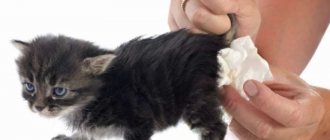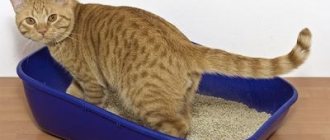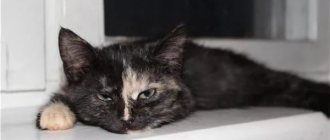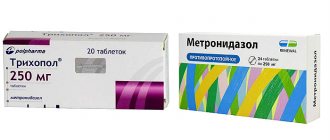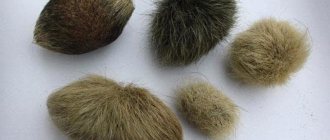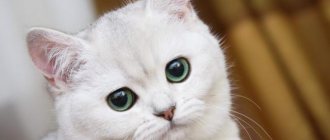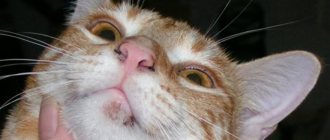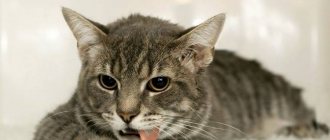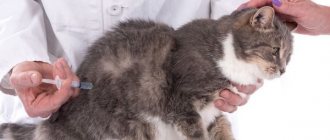Diarrhea that appears once in a cat is not always a sign of the development of pathology. The reason may be an incorrectly selected food set (for example, incompatible products with natural feeding). If a cat develops diarrhea with bloody streaks, accompanied by a change in the general condition of the animal, this is a reason to immediately consult a doctor.
In addition to bloody diarrhea, the pet vomits and the body temperature rises, which indicates serious changes, such as intoxication of the body or exacerbation of chronic diseases. The appearance of bloody diarrhea is a reason to immediately consult a veterinarian for advice. Otherwise, the cat may die from extensive hemorrhages or dehydration.
General information
Diarrhea (popularly called diarrhea) is a digestive disorder that requires mandatory treatment. With each bowel movement, the pet's body loses a large amount of fluid, weakens and becomes depleted. If not treated promptly, diarrhea can lead to the death of the animal.
Diarrhea is often accompanied by nausea, abdominal pain, and vomiting. The animal experiences discomfort, anxiety, stress. He loses his appetite.
Diarrhea in a cat: how to properly treat an upset stomach
Diarrhea may also be accompanied by:
- fever;
- flatulence;
- fatigue, lethargy;
- nausea;
- vomiting;
- bloody discharge.
Diarrhea is not an independent pathology, it is only a symptom of existing health problems in your pet.
Signs of dehydration
Diarrhea causes loss of fluid in the body. The animal becomes weak and lethargic.
The first signs of dehydration:
- pallor of the mucous membranes;
- lethargic state;
- eyes sunken into their sockets;
- refusal of food.
If the cat is not vomiting, it must be given clean water using a syringe. You can inject a 0.9% chloride solution in an amount of 5 ml under the withers.
When to see a doctor
You need to contact your veterinarian urgently if:
- the cat is in pain;
- increased salivation;
- the appearance of blood in the urine;
- stool has a black tint mixed with blood;
- vomiting appears.
What is the cause of diarrhea in cats?
The causes of diarrhea in a pet can be situational, arising from errors in care, or serious, due to diseases of varying severity.
Household factors leading to disruption of the gastrointestinal tract and diarrhea:
- incorrect diet - feeding your pet fatty, smoked foods, raw fish, milk;
- overfeeding;
- a sharp change in the usual diet - replacing the natural method of feeding with dry food, changing food from wet to dry or vice versa;
- drinking water - a sudden change in the composition of water can adversely affect digestion;
- food poisoning – eating spoiled food;
- food allergies to certain foods;
- the cat’s body’s reaction to medications;
- postoperative recovery period;
- stress – the general condition of a cat in response to a change of environment, a trip, another animal, the absence of the owner;
- short-term diarrhea occurs in cats during pregnancy and after birth.
Among the diseases whose symptom is diarrhea are:
- bacterial infections - salmonella, E. coli and others;
- viruses - rotavirus, feline leukemia, peritonitis, panleukopenia and others;
- liver damage;
- pathologies of the digestive system, pancreatitis, intestinal obstruction;
- serious intoxication of the animal’s body due to poisoning;
- metabolic disorders, incl. diabetes;
- the presence of internal parasites - worms, worms, roundworms;
- oncological diseases;
- kidney disease;
- mycoses (fungal infections) of animals.
You can determine the specific cause of diarrhea in a cat by knowing the types of diarrhea.
Types of diarrhea and diagnosis
Associated symptoms
Diarrhea and vomiting indicate problems with the digestive system. The reasons may be different; to establish them, you will need the help of a veterinarian.
Factors that provoke diarrhea and vomiting:
- tumor;
- bacterial infections;
- poisoning;
- kidney and liver diseases;
- sunstroke.
An unpleasant odor in loose stool indicates inflammatory processes in the animal’s body. It is also important to pay attention to the color of the diarrhea and its consistency .
Types of diarrhea and diagnosis
The color, consistency and smell of diarrhea differ in each case and allow an accurate diagnosis to be made.
Diagnosis of stool by consistency
The consistency and presence of various inclusions in the stool make it possible to determine the problem organ:
- vomiting with foam and loose stools are symptoms of food poisoning;
- feces with mucus are the result of damage to the large intestine, while the cat often strains to no avail;
- diarrhea with blood - the result of infection or internal parasites;
- watery diarrhea is a symptom of mild poisoning or a disease without damage to the intestines.
Diagnosis of stool by color
The color of feces most fully allows you to determine the problem with your pet’s health:
- yellow diarrhea signals an incomplete digestive process; food has not been digested sufficiently;
- black stool is the result of taking iron-containing drugs, an excessively “meaty” diet, severe damage (bleeding) of the small intestine;
- green diarrhea is formed as a result of rotting processes of spoiled food in the intestines;
- white color indicates the absence of bile in the stool as a result of pathologies of the biliary tract;
- orange color is an indicator of liver problems, severe intoxication of the cat’s body.
Signs of the most dangerous diseases are inclusions of blood and mucus, black, white and orange stool. In these cases, contacting a veterinarian should be done immediately.
Methods for treating diarrhea in cats
Clinical picture
Of course, the main and undeniable symptom is diarrhea. The main difficulty lies in determining the location of the lesion. There is a big difference in the treatment of the small and large intestines. In particular, if a pet has problems with the large intestine, the owner will be able to observe the following for their pet:
- Increased frequency of attempts to defecate.
- The animal will strain very hard.
- There will be clearly visible blood in the stool, as well as mucus.
On the contrary, with lesions of the small intestine (except for cases of very severe hemorrhages), you most likely will not see blood in the stool at all. More precisely, the stool will be a blackish-brown mass called melena. This is what digested blood looks like. Accordingly, in episodic and rare situations where it enters the small intestine, the owners may not notice anything at all. The feces will just be a little darker than normal. If a cat goes outside to do “business”, he may well die “safely” from intestinal bleeding and anemia.
So the conclusion is simple. It is not always possible to learn about diarrhea (except in advanced situations) “visually”. However, when an exhausted and exhausted cat begins to walk under itself, everything becomes obvious, but it may be too late to treat it. You need to look at the general condition of your pet and examine it more often. A healthy cat will never have fecal marks on the fur around the anus . If any are observed, we are 100% talking about diarrhea.
Treatment methods
Self-selection of medications is highly discouraged and is dangerous for the pet’s life. A veterinarian can make the correct diagnosis.
Treatment at home
Treatment at home is possible for mild illnesses or as a correction for mistakes in caring for the animal.
So, if diarrhea is caused by a stressful situation, you should provide the animal with rest, and, if possible, eliminate the cause of anxiety.
If you have an unhealthy diet, you need to take a more responsible approach to compiling your cat’s diet and eliminate possible allergens. Be sure to remove any spicy, fatty or fried foods and dairy products from the animal’s menu. You cannot feed your cat spoiled foods and sweets, because... this leads to poisoning.
Diarrhea during pregnancy is short-lived, no more than 3 times. If the specified amount is exceeded, diarrhea may indicate problems in the cat that require the intervention of a veterinarian.
Diarrhea after childbirth and other operations is short-lived and goes away on its own, because... caused by a stressful situation.
If there are household factors causing diarrhea, as well as with mild diarrhea without dangerous accompanying symptoms, a cat can be cured by fasting.
A fasting diet carried out throughout the day will relieve the digestive system. Dietary restrictions will give the cat's body the opportunity to heal on its own. It is important to note that a strict diet only concerns food. You should not deprive a sick pet of fresh water.
Due to the peculiarities of digestion, a cat cannot starve for more than a day, as this will unnecessarily weaken the animal.
After finishing the diet, you should not immediately load the animal’s digestive system. You should feed little by little, but often. The best feeding option on the first day would be boiled chicken, or dry or wet food for weakened animals.
As medicinal aids you can give your cat:
- rice water;
- Activated carbon;
- chamomile decoction;
- Smecta.
Do not give human antidiarrheal medications to cats. Probiotics (beneficial microorganisms) can be given without a veterinarian's prescription in the dosages specified in the instructions for the drugs.
If a daily starvation diet does not help your pet, you should immediately take your cat to a veterinary clinic for an accurate diagnosis and selection of treatment.
Treatment in the clinic
The veterinarian will make a reasonable diagnosis not only based on the observation of the cat owner, but will also conduct the necessary tests.
You should contact a specialist immediately if:
- the animal experiences apathy, severe weakness, lies down;
- there is an elevated temperature;
- diarrhea is accompanied by vomiting and cramps;
- the pet does not drink water;
- diarrhea contains impurities of blood and mucus;
- stool is orange, black or white;
- frequency of bowel movements – more than five times a day.
Depending on the specific disease, the veterinarian will prescribe:
- sorbents for severe pet poisoning (Smecta, activated carbon, Enterosgel);
- antibiotics for bacterial infection - Enterofuril;
- probiotics are prescribed after completing a course of antibiotics to restore the correct microflora of the cat’s gastrointestinal tract;
- anti-inflammatory drugs – if problems are detected in areas of the digestive system;
- antiviral drugs – the appropriate one is selected for each specific virus;
- anthelmintic drugs – to remove internal parasites;
- saline solutions are administered intravenously in case of severe dehydration;
- antiemetic drugs – Cerucal, to eliminate the symptoms of vomiting and nausea;
- surgical intervention - if a tumor is detected or severe blockage of the intestine.
All of the listed drugs are prescribed by a veterinarian in combination with supporting medications and vitamins. Depending on the severity of the disease, treatment can be long-term and multi-component.
Nutrition
The cat should not be allowed to go hungry for more than 24 hours. From the 2nd day of illness, the pet is fed small portions at regular intervals.
Diet rules for diarrhea with blood and mucus:
- Give small portions every 2 hours.
- Use fresh products.
- Steamed or boiled. Add a little salt.
- Do not feed raw meat.
- Be sure to drink enough water.
- Food should be warm.
If the cat has been eating dry food, replace it with wet food. Reduce the portion. You can change your regular food to a diet line.
What you can do:
- boiled lean meat;
- boiled fish;
- baby meat food;
- porridge cooked in water;
- pasta.
What not to do:
- fatty and fried foods;
- raw fish and meat;
- bones;
- dairy products.
The diet is maintained during the illness and 2 weeks after recovery. This is necessary to restore intestinal function.
If the diarrhea is black
global $ads_google;
//data-ad-slot=”2475549904″ $ads_google = empty($ads_google) ? false : true; ?> if ($ads_google == false) {?> $ads_google = true; ?> } ?> Mustard-colored liquid feces in kittens is normal, but the black color called “melena” is not at all present. This is evidence of problems in the body, unless, of course, there are preparations containing iron in the diet, or there is an excessive amount of raw meat or blood meal.
The list of diseases associated with red-black diarrhea is long; you cannot cope with this on your own; consult a doctor.
